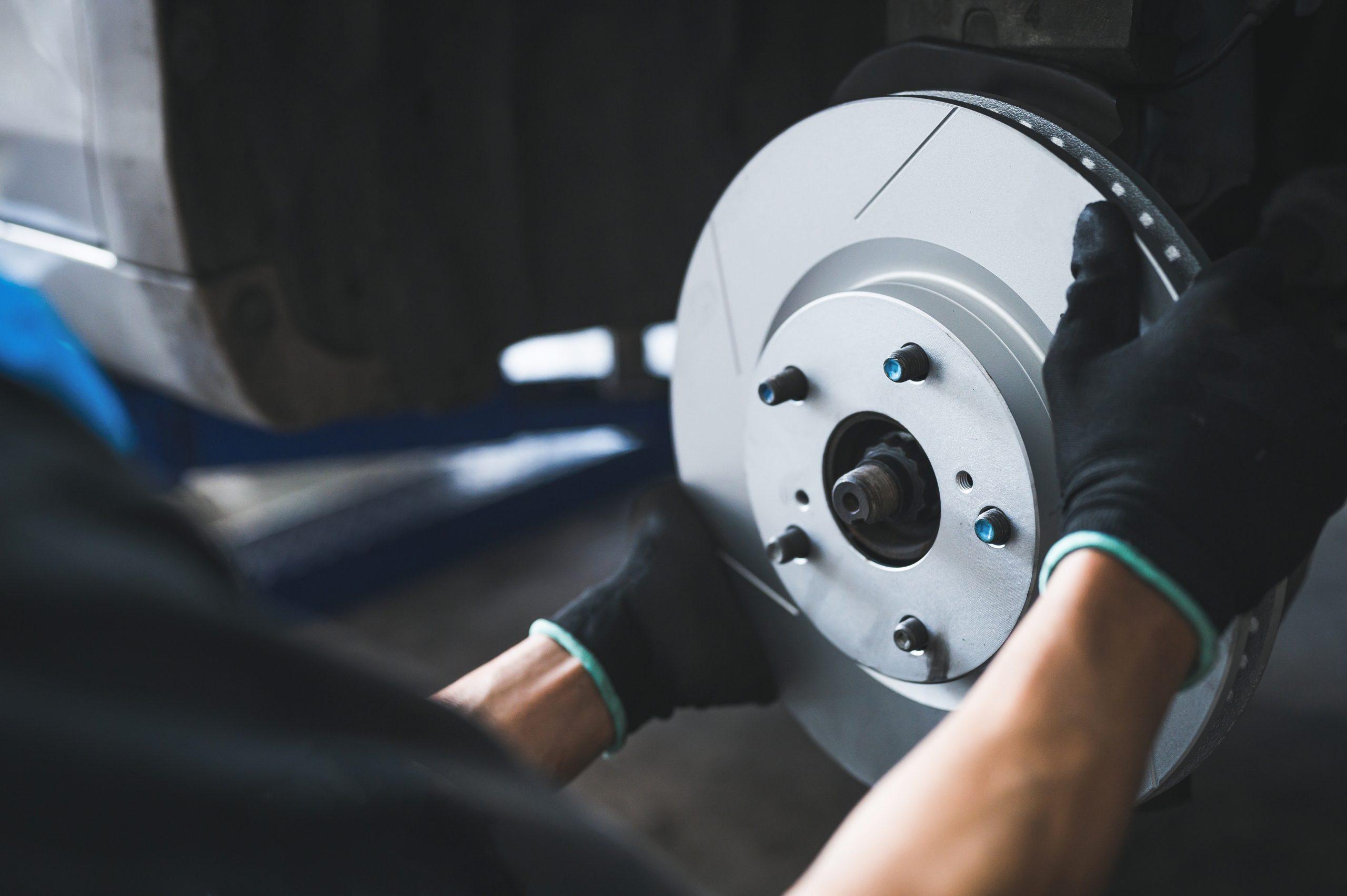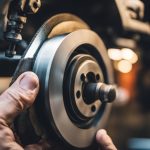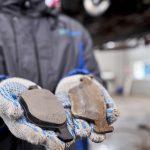
Knowing When to Replace Your Brakes: A Comprehensive Guide
- Harbor Brakes
- December 5, 2023
- Brakes
- brake disc, brake fluid, brake pads, brake repair, brake rotors, brake service, brakes, pads, rotors
Are you unsure when it’s time to replace your brakes? Knowing the signs that indicate brake pad and rotor replacement is essential for maintaining the safety and efficiency of your vehicle’s braking system. In this comprehensive guide, we’ll explore the key indicators that it’s time to replace your brakes, including screeching or squeaking sounds, grinding noises, the brake light turning on, longer stopping distances, and shaking when braking.
Key Takeaways:
- Screeching or squeaking sounds when braking may indicate the need for brake pad replacement.
- Grinding noises suggest that both the brake pads and rotors may need to be replaced.
- A brake light turning on can be an indication that it’s time to replace the brake pads.
- Longer stopping distances may be a sign of worn brake pads or other issues within the braking system.
- Shaking or vibrations when braking may be due to unevenly worn brake pads and warped rotors.
By paying attention to these signs and addressing any necessary brake repairs or replacements promptly, you can ensure the ongoing safety and efficiency of your vehicle’s braking system.
Screeching or Squeaking Sounds
One of the most common signs that your brake pads need to be replaced is the presence of screeching or squeaking sounds when braking. These noises can be quite alarming, but they serve as an important indicator that something is wrong with your braking system. The screeching or squeaking sounds are usually caused by the wear indicator on the brake pads, which is a small metal tab that is designed to touch the brake rotor when the pads are worn down to around 25% of their original thickness.
Ignoring these sounds and continuing to drive with worn brake pads can lead to further damage not only to the brake pads but also to the brake rotors. As the metal backing of the worn brake pads comes into contact with the rotor, it can cause deep grooves and scoring on the surface, affecting the efficiency of the braking system and potentially causing damage to other components of your vehicle.
Therefore, if you notice screeching or squeaking sounds when braking, it is crucial to have your brake pads inspected and replaced as soon as possible to ensure the ongoing safety of your vehicle and to prevent any further damage to the braking system.
| Signs of Worn Brake Pads | Potential Consequences |
|---|---|
| Screeching or squeaking sounds | Damage to brake rotors, reduced braking efficiency |
| Grinding noises | Destruction of brake pads and rotors, compromised braking performance |
| Brake light turns on | Indicates low brake pad thickness, potential brake failure |
| Longer stopping distances | Increased risk of accidents, damage to brake calipers and rotors |
| Shaking when braking | Warped rotors, uneven brake pad wear, diminished braking effectiveness |
Grinding Noises
If you hear a grinding noise when braking, it is a clear indication that your brake pads have worn down completely and the metal backing plate is now rubbing against the brake rotor. This can cause significant damage to both the brake pads and the rotors. In this case, it is necessary to replace both the brake pads and the rotors to maintain a safe and effective braking system.
The grinding noise occurs because the brake pads, which have a metal backing plate, have worn down beyond their usable thickness. When the backing plate comes into contact with the rotor, it creates a harsh grinding sound. Ignoring this noise can lead to further damage, including warping of the rotor surface.
To resolve this issue, it is essential to replace both the brake pads and the rotors. This ensures that the new brake pads will have a smooth and flat rotor surface to adhere to, allowing for proper braking performance. If only the brake pads are replaced without addressing the worn rotors, the new pads will not provide optimal contact, leading to decreased braking efficiency and potential safety concerns.
Metal on Metal: The Dangers
When the brake pads have worn down to the point of metal on metal contact, it creates a dangerous situation. The metal backing plate rubbing against the rotor can cause excessive heat, leading to brake fade and reduced stopping power. Additionally, the friction generated can cause significant damage to the rotor, resulting in the need for more extensive repairs.
Ignoring grinding noises when braking is not only unsafe but can also result in costly repairs. It is crucial to have your brake pads and rotors inspected and replaced as necessary to ensure the ongoing safety and performance of your vehicle’s braking system.
Table: Signs of Worn Brake Pads and Recommended Actions
| Signs of Worn Brake Pads | Recommended Actions |
|---|---|
| Screeching or squeaking sounds | Have brake pads inspected and replaced if necessary |
| Grinding noises | Replace both brake pads and rotors |
| Brake light turns on | Inspect and replace brake pads as needed |
| Longer stopping distances | Have brake pads and calipers inspected and replaced if necessary |
| Shaking when braking | Replace both brake pads and rotors |
Brake Light Turns On
If you notice that the brake light on your dashboard turns on, it can be a clear indicator that it’s time to replace your brake pads. Some vehicles are equipped with a brake pad sensor that triggers the brake light when the brake pads have worn down to a certain level. This serves as a warning sign that should not be ignored.
When the brake light turns on, it’s important to have your brake pads inspected and replaced as necessary. Continuing to drive with worn brake pads can jeopardize the safety of your vehicle, as the diminished brake pad thickness can reduce the effectiveness of braking. Prompt replacement of the brake pads can help ensure the ongoing safety and performance of your braking system.
When replacing the brake pads, it’s recommended to consult a professional mechanic or follow the manufacturer’s guidelines. They will be able to recommend the appropriate brake pads for your specific vehicle make and model. Regular maintenance and prompt attention to the brake light indicator can help prevent further damage and ensure optimal braking performance.

Brake Pad Replacement Checklist
- Inspect the brake pads for wear and thickness.
- Measure the brake pad thickness using a caliper tool.
- If the brake pads are worn down to the minimum thickness, replace them.
- Check the brake pad sensor and replace it if necessary.
- Ensure proper installation of the new brake pads.
- Test the brakes to ensure they are functioning correctly.
| Signs of Brake Pad Wear | Action |
|---|---|
| Brake light indicator turning on | Inspect and replace brake pads as necessary |
| Screeching or squeaking sounds when braking | Inspect and replace brake pads as necessary |
| Grinding noises | Replace brake pads and rotors |
| Longer stopping distances | Inspect and replace brake pads as necessary |
| Shaking or vibrations when braking | Replace brake pads and rotors |
Longer Stopping Distances: A Sign of Worn Brake Pads
If you’ve noticed that your vehicle takes longer to come to a complete stop when braking, it could be an indication that your brake pads are worn down. When brake pads become thin or low, they are not able to provide sufficient friction to the brake rotor, resulting in longer stopping distances. This can be dangerous, especially in emergency situations where quick and responsive braking is essential.
One of the reasons for longer stopping distances is the decreased ability of the brake pads to create the necessary friction. As the brake pads wear down, there is less material available to make contact with the brake rotor, which reduces the overall stopping power. Additionally, low brake pads can put increased stress on the brake caliper, as it needs to apply more force to generate adequate braking performance.
Causes of Longer Stopping Distances:
- Low brake pad thickness
- Reduced friction between brake pad and rotor
- Inadequate braking force from the brake caliper
It is crucial to address longer stopping distances promptly to ensure your safety and the safety of others on the road. By replacing the worn brake pads and addressing any underlying issues with the brake caliper or rotor, you can restore the optimal braking performance of your vehicle and reduce the risk of accidents.
In some cases, longer stopping distances may also be caused by other factors, such as worn brake rotors. If the brake rotor surface is damaged or uneven, it can reduce the contact area with the brake pads, leading to reduced braking efficiency. Therefore, it is important to have a comprehensive inspection of your braking system to identify any potential issues and address them accordingly.

Table: Signs and Causes of Brake Pad Wear
| Signs of Brake Pad Wear | Causes |
|---|---|
| Screeching or squeaking sounds | Wear indicator on brake pads touching the rotor |
| Grinding noises | Brake pads worn down completely, metal backing plate rubbing against the rotor |
| Brake light turns on | Brake pads worn down to a certain level, triggering the brake light indicator |
| Longer stopping distances | Low brake pad thickness, reduced friction, inadequate braking force |
| Shaking when braking | Uneven brake pad wear, warped rotors |
Shaking When Braking
If you experience shaking or vibrations when applying the brakes, it may indicate that your brake pads are wearing unevenly, causing the rotors to warp. This can result in an improper adherence of the brake pads to the rotor surface, leading to inefficient braking. To resolve this issue, it is recommended to replace both the brake pads and the rotors. This will ensure that the new pads adhere to a flat and smooth rotor surface, allowing for proper braking performance.
Impact of Shaking When Braking
When your brake pads and rotors are not in optimal condition, the shaking or vibrations felt when braking can have a significant impact on your driving experience. It can affect your ability to maintain control of the vehicle, increasing the risk of accidents. Furthermore, the uneven wear of brake pads and warped rotors can lead to premature wear and tear on other components of the braking system, resulting in costly repairs.
Ignoring the shaking when braking can also have long-term consequences for the safety and efficiency of your vehicle. The uneven pressure applied to the rotors can lead to hot spots and glazing, reducing the overall effectiveness of the brake pads. This can result in longer stopping distances and compromised braking performance, putting both you and other road users at risk.
Brake Pad and Rotor Replacement
When it comes to addressing the issue of shaking when braking, it is important to replace both the brake pads and the rotors. This ensures that the braking system is restored to its optimal condition, allowing for smooth and effective braking. Consult with a professional mechanic to determine the best replacement options for your specific vehicle model and driving needs.
| Signs of Shaking When Braking: | Possible Causes: |
|---|---|
| Shaking or vibrations felt when applying the brakes | Uneven wear of brake pads |
| Warped rotors | Improper adherence of the brake pads to the rotor surface |
| Reduced braking performance and longer stopping distances |
By promptly addressing the issue of shaking when braking and replacing the brake pads and rotors as necessary, you can ensure the safety and efficiency of your vehicle’s braking system. Regular maintenance and inspections are key to identifying and resolving any issues before they escalate, allowing you to enjoy a smooth and reliable driving experience.
Conclusion
Regular brake maintenance is essential for the safety and optimal performance of your vehicle’s braking system. By staying vigilant and addressing signs of brake wear, such as screeching or squeaking sounds, grinding noises, the brake light turning on, longer stopping distances, and shaking when braking, you can ensure that your brakes are in top shape.
Brake repair and service should be conducted promptly to prevent further damage and maintain your braking efficiency. It is recommended to have your brakes inspected regularly by a professional to identify any potential issues before they become major problems.
Remember, proper brake maintenance not only keeps you safe on the road but also extends the lifespan of your brake components. So, stay proactive and prioritize brake inspection and maintenance to enjoy a smooth and reliable driving experience.
FAQ
What are the signs that indicate it’s time to replace your brake pads and possibly your brake rotors?
The signs include screeching or squeaking sounds, grinding noises, the brake light turning on, longer stopping distances, and shaking when braking.
What causes screeching or squeaking sounds when braking?
Screeching or squeaking sounds are often caused by the wear indicator on the brake pads, which indicates that the pads are worn down to around 25% of their original thickness.
What should I do if I hear a grinding noise when braking?
A grinding noise indicates that your brake pads have worn down completely and the metal backing plate is now rubbing against the brake rotor. In this case, it is necessary to replace both the brake pads and the rotors.
Why does the brake light turn on?
Some vehicles are equipped with a brake pad sensor that triggers the brake light on the dashboard when the brake pads are worn down to a certain level. This serves as an indication that it’s time to replace the brake pads.
What does it mean if it takes longer for my vehicle to come to a complete stop when braking?
Longer stopping distances can be a sign that your brake pads are worn down and the brake caliper is having difficulty applying enough pressure to the brake rotor. It is important to address this issue promptly to prevent any potential accidents or further damage.
Why do my brakes shake or vibrate when I apply them?
Shaking or vibrations when applying the brakes may indicate that your brake pads are wearing unevenly, causing the rotors to warp. To resolve this issue, it is recommended to replace both the brake pads and the rotors.
What should I do to ensure the safety and efficiency of my vehicle’s braking system?
Regular maintenance and prompt attention to signs of brake wear are crucial. It is recommended to have your brakes inspected regularly and to address any issues promptly to prevent further damage and ensure optimal braking performance.
Source Links
- https://nubrakes.com/blog/6-signs-its-time-to-replace-brake-pads/
- https://www.brakestoyou.com/post/5-signs-its-time-to-replace-your-brake-pads
- https://tireworks.net/your-guide-to-knowing-when-its-time-for-a-brake-repair/

